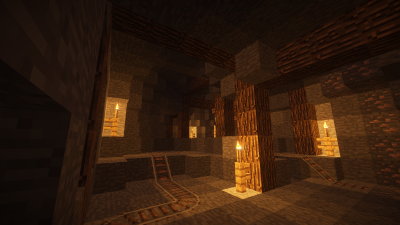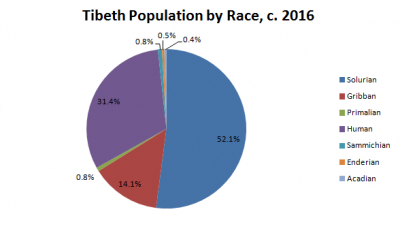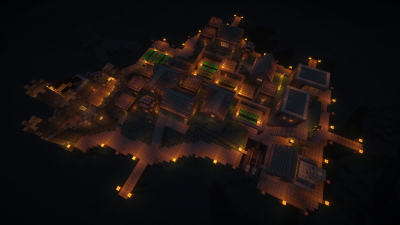Tibeth
Tibeth is a small village near the southern edge of the Shire. Founded by settlers from the Solurian Empire, Tibeth is a vibrant community that centers around the export of iron ore and ingots.
History
Tibeth was founded shortly before Gosd, by the Gribban Compact, and was later brought into the Solurian Empire when the the two states merged.
Overview
Pre-War Tibeth
Tibeth was originally founded by Gribban Compact settlers in early 211, and was the first Gribban colony ever founded. Discounting Grib, the main city, Tibeth is the oldest Gribban settlement in recorded history. Tibeth was originally the site of a small forest, but after Gribban sailors saw the island which would later be Gunderhelm, and thought it was the mainland, a small port was made. From there, A small settlement developed rapidly until it was discovered that the ocean continued. At that point, development of the isle halted and woodcutting increased until the point the island was completely depopulated of trees.
After a few years of stagnation, in 313, Gribbans decided to begin mining in Tibeth to perhaps discover a few minerals that could be traded with the newly contacted Solurian Empire. By sheer luck, they discovered one of the largest iron deposits in the Shire. After mining continued for a few years, however, it was discovered that the mining of iron had severe health effects on Gribban miners, so the development of the mine halted. In 319, Solurian miners were contracted to mine for a small share of the ore that was mined.
Almost immediately, the Solurian miners realized the sheer value a mine in this location could pose, and investors and buyers began pouring in from all over the Solurian Empire. Rapidly, citizens of the Solurian Empire began outnumbering Gribbans on the island, until the ratio of Solurians to Gribbans was nearly 20:1. Despite this, relations were amicable, as the Gribban landowners were glad to have Solurians mine what had, at that point, become useless ores for the Gribban Compact. As Gribbans moved further and further towards organic building materials and away from common building materials, and as iron became less and less valuable to their way of living, landowners began selling their shares of Tibeth to Solurian buyers.
Tibeth would later serve as a point along the Grib to Gosd route, with Solentse as another point for trade. By 1207, Tibeth’s mining operations were fully owned by members of the Solurian Empire, and Gribban taxation was at an all time low for the mining and exportation of iron from Tibeth. Trade between Tibeth and Solentse rose sharply during this year as the major effort to refurbish and reinforce Solentse’s southern wall began in earnest. Iron from Tibeth was critical for reinforcing the stone structure and, later on, establishing a system of lighting the wall at night.
During a rapid expansion of the Gribban naval forces in 1710, following the rise in tensions between the Gribban Compact and the Solurian Empire’s Avetissmens political party, iron exportation to Grib spiked and nearly overwhelmed the trade routes until the small waystation Zvez was founded to the southeast of Tibeth. In 1713, a riot by Avetissmens party members resulted in the death of Tibeth’s mayor and political heads, leading to a sharp crackdown on the Solurian Empire’s citizens residing in Tibeth. From 1713 until 1716, Gribbans in the town lived in a minor state of fear, as Tibeth rapidly and disconcertingly developed into the only point of power for the Avetissmens party in the southern reaches of the Solurian Empire.
Tibeth during the Civil War
When the Solurian Civil War of 1717 began, Tibeth was among the first towns and cities seized by the Avetissmens as fighting broke out across the Solurian Empire. Members of the Avetissmens party, now acting against the Solurian Empire, killed nearly 70% of the Gribbans in Tibeth and took the rest hostage, along with citizens of the Solurian Empire who did not belong to the Avetissmens. This act of violence early on in the war was later known as the Massacre of Tibeth, and was later one of the vital points in the trial of war criminals from the remnants of the Avetissmens group.
As the Solurian Empire and the Gribban Compact probed the defenses of Tibeth, which had been shored up in the year preceding the war’s beginning, these hostages were forced to work in the mine nearly nonstop in order to provide iron for the Avetissmens war effort. Thirteen heavy-duty iron-plated warships were nearly completed in Tibeth, but Gribban naval forces successfully managed to sink or destroy them before they could sail on the open ocean. If these warships had been allowed to assist the Avetissmens in naval combat, it is possible the result of the Solurian Civil War of 1717 could have changed drastically.
From Tibeth, mercenary and naval forces moved west to Solentse and northwest to Gosd to take place in the First Battle of Gosd and the Second Battle of Solentse, both large losses for the Avetissmens force. However, when forces of the Avetissmens left Tibeth to partake in the Siege of Solentse in late 1718, ships from the Solurian Empire that were based out of Solentse and ships from the Gribban Compact based out of Grib which had been lying in wait off the coast of Zvez assaulted Tibeth in what became known as the Naval Battle of Tibeth. While a dangerous strategy, as it left Solentse open to naval attack, the assault was successful, and the southern Avetissmens naval force was decimated. Unfortunately, it became known that several Avetissmens warships had left to blockade Gosd in the Second Battle of Gosd. If Gosd was taken, then the stronghold of the Solurian Empire’s forces stationed in Solentse would be cut off from northern support and surrounded by Avetissmens forces.
In a race against time, the naval force that took Tibeth had to break the Avetissmens siege on Solentse in the Siege of Solentse and sail north to Gosd to prevent its fall. In the aftermath of the freeing of Tibeth, the Solurian and Gribban citizens who were forced to work in the mines were freed, though nearly 97% of them died later on from complications of working in the mines under such harsh conditions. Of the original survivors of the Tibeth Massacre, barely two thousand survived until the end of the civil war and the ensuing war trials. The evidence present and the tales the survivors told afterwards were crucial in the capture and execution of those who were responsible.
Modern-day Tibeth
Tibeth’s population in the modern day still hasn’t recovered from the Massacre of Tibeth, the deaths of the miners who were forced to work during the war, and those who were members of the Avetissmens party that died during the war. Despite this, efforts to rebuild have been ongoing, and development of the mine has steadily continued. New laws and regulations were put in place to deal with concerns of the mining operations, and the quality of the mine has been worked on to steadily improve the lifespans of the miners and the conditions they have to work in. Despite this, barely any of the original families in Tibeth work in the mines.
A small spa was built on the island, which results in a small draw of tourists as it is the only spa in the deep southern Solurian Empire. Besides this, however, most of Tibeth is simply a mining town, with very little seasonal tourism.
Tibeth Iron Mine

The Tibeth Iron Mine was started when settlers discovered a vein of iron just under the surface, and has been mined until the current day. While not the largest source of iron exportation, the Tibeth Iron Mine has been a stable source of iron for investors and buyers in the market. Exportation from the Tibeth Iron Mine has been the main source of work for the entire dock area of Tibeth, and accounts for 92% of exports in the Tibeth economy. This mine also employs over 80% of the population of Tibeth, including some members of the military who work on their off days.
However, following the excavation of an iron vein in late 2015, miners broke through a thin layer of ore into a large cavern below. Unfortunately, sixteen miners died in this event, and this has halted further mining until an investigative group can determine if the cavern extends below the rest of the mine and possibly destabilizes what has been mined out already. This has heavily affected the trade of Tibeth, and a merchant ship has anchored offshore to collect the remaining iron and drop off members of the investigative team. Besides this ship, unfortunately, no other trade ships are docked.
Most of the iron trade has begun turning to the Hoch Quarry Complex to the far east in terms of iron supply and mining, posing a possible danger for Tibeth’s future economy even if the mine is reopened.
Demographics
Information in Tibeth for population values prior to the civil war are hard to come by, due partly to the attempts by surviving Avetissmens members to erase information of their crimes and partly due to the damage caused by the fighting. However, Tibeth’s population before the war was likely 80,000 through 90,000, but after the war, according to the 1720 census, the population was roughly 2,000. Since then, due to mining operations and immigration, the population has grown, but unfortunately not remotely close to the amounts it was at before the Solurian Civil War of 1717.

According to the 2016 census, there were 3547 Gribbans, 13107 Solurians, 191 Primalians, 7895 Humans, 207 Sammichians, 119 Enderians, and 104 Acadians living in permanent manner in Tibeth. The total permanent resident population in Tibeth is 25,170, as of the most recent census. Due to this, Tibeth is one of the smaller towns in the Solurian Empire.
Religion
Tibeth is not too overly religious, but there is a small church in the fort which is used for religious gatherings. Despite the main religion, the Solurian Sect, being introduced in early 315, no main church or temple was built over the years. Instead, followers of the religion opted to dedicate small shrines in their homes, likely a byproduct of the long work days in the mines or on the docks.
In Tibeth, 95.16% of the population follows the Solurian Sect religion, according to the 2016 census. This is almost all from the Gribban, Solurian, Primalian, and Human population groups, with only 2% of the Human population not following this religion. The variety of other religions are split between the original religions of the Sammichian, Enderian, and Acadian homelands. Only 0.17% of the population of Tibeth opted to withhold religious views on the 2016 census.
Political Climate
The political climate in Tibeth is somewhat reserved, mostly due to the military occupation of Tibeth from 1719 to 1800 following the end of the Solurian Civil War of 1717. As such, the citizens of the Solurian Empire that can vote mostly vote for the military-minded Principal Sol Compact, or P.S.C., when election time comes around. Despite the history in Tibeth, however, as the population has grown and times have changed, there has been a small growing of support for the Collaborative Solurian Party (C.S.P.) and the Solurian National Group (S.N.G.) in recent elections.
For those who chose to put the information on the census forms, the P.S.C. holds majority support at 61.5%, with 17.2% support for the C.S.P. and 21.3% support for the S.N.G. 89% of the population of Tibeth filled out political affiliation forms on the census forms.
Military Climate
The military climate in Tibeth is somewhat stifling due to the rough history of the town. Most of the military force is stationed in the small fort on the island. However, military forces from Tibeth are supplemented by those from Zvez to the east. The military holds little to no influence with the police force of Tibeth, and instead acts in separate form in the event of mining protests, though this has not been necessary since late 1893 due to the constantly improving laws and regulations on working in the mine.
Since the collapse of the Tibeth Iron Mine’s newest mineshaft in 2015, the military forces in Tibeth have been hard pressed in keeping the peace with the members of the police, as the miners grow more and more frustrated in the lack of work or income. Reinforcements to the military and police force of Tibeth have been coming in from Solentse, Zvez, and even Grib as the large majority of the population descends into unrest as savings and spending money has slowly dropped into nothing. What little tourism Tibeth had has rapidly decreased as the stability of Tibeth comes further into question, with a rise of riots and protests by the unemployed miners and mine owners throwing the town into a state of disarray. Efforts by the military to keep the peace long enough for the investigation of the mines to complete are sometimes left alone, but are often swept into the general rioting that occurs.
Talks have been in place recently in Grib to decide whether to send military reinforcements into Tibeth to establish a more permanent base and begin cracking down on crime and rioting in the town, but a decision by the Solurian Empire’s leading authorities has not yet been agreed upon.
Build History

Tibeth was originally a generated village that was claimed by and expanded upon by Master_Chief in mid 2015, likely after the completion of Gosd. As of now, there is no warp, but if Tibeth is revamped into a heavy duty military fort/town with a larger mine, it is likely a warp will be added. It is unsure if this revamp will occur as of this current wiki update.